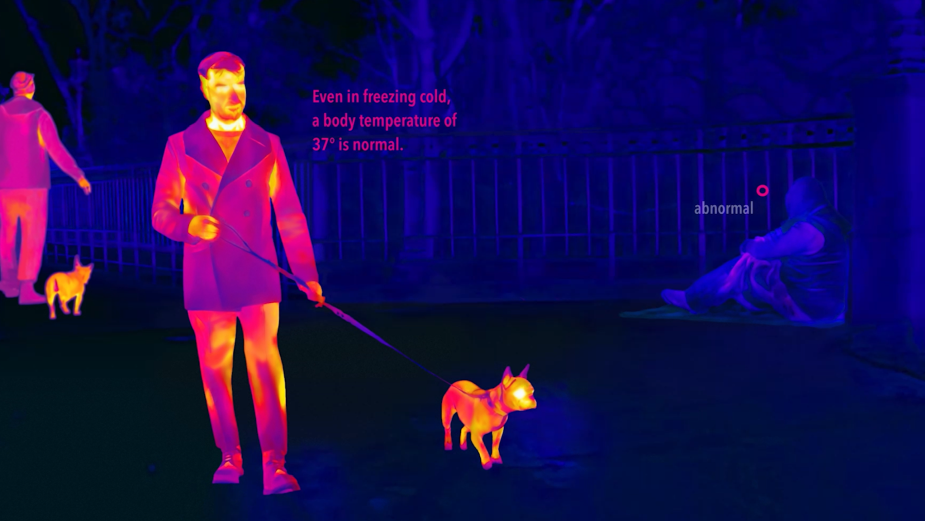
How fiftyfifty Showed the Social and Physical Coldness of Homelessness

Climate change is resulting in warmer temperatures and differing climates but in Germany, the winters remain as cold as ever and extreme frosts are on the rise – a deadly issue for the homeless population. In its ‘Winter in Germany’ campaign, street magazine fiftyfifty and Havas Germany decided to create a campaign not just showing the physical but also the social coldness of homelessness.
Taking on thermal imagery, the campaign captures many people walking, cycling and rushing home to avoid the cold, while going past many unnoticed homeless people. Those hurrying past glowed both red and yellow when captured on thermal images while, to the audience’s shock, a homeless person blends into the background as a totally blue figure. The stark comparison between homeless people’s dangerously low body temperatures and those who are warm makes viewers realise that they are at serious risk of deadly frostbite. There’s one figure that made it all very clear:
‘The number of homeless who froze to death increased by 500%’ as per the last decade.
To change this, Alexander Schon, senior art director at Havas Germany tells LBB’s Nisna Mahtani why it was important to spread warmth during bitterly cold months.
LBB> Tell us a little about what fiftyfifty does and what it wanted to say with this campaign.
Alexander> fiftyfifty is a homeless charity organisation based in Düsseldorf that helps homeless people with various measures and initiatives. Among other things, they help the local homeless get through winter, when it’s actually a matter of life and death for many. Our campaign ‘Winter in Germany’ aims to draw attention to exactly this underestimated issue. Because the number of homeless people who have frozen to death in Germany in recent years has increased dramatically by 500%. I think very few are aware of this development and existing problem.
LBB> Can you tell us about some of the initial ideas which came through the brainstorming process and how you landed on this one? When did using thermal imagery first come into the conversation?
Alexander> The starting point was the mentioned fact that more and more homeless people freeze to death in winter, which I found truly shocking. And I thought, something had to be done about it. Since then, the topic was stuck in the back of my mind. Eventually, the inspiration for the idea came by chance when I fell into one of those YouTube rabbit holes, where you start with ‘how to cook the perfect carbonara?’ and end with ‘here are cows with fluffy fur’. One of these videos used thermal camera footage – a rare technique that simply felt like the perfect fit to address the topic in a most tangible way.
LBB> With global warming as a major topic at the moment, why was it important to highlight the impact of the cold in this campaign?
Alexander> Climate change is causing rising temperatures, that much is true. But this is only one side of the coin. On the other side, occurrences of weather extremes, such as hard frosts with constant temperatures below freezing point, are increasing equally. However, this side of climate change and the resulting consequences for homeless people are not sufficiently in the public consciousness and that is exactly what we aim to improve with ‘Winter in Germany’.
LBB> Tell us a little bit about your use of thermal imagery in this campaign and why it was so effective in conveying the message of social and literal coldness.
Alexander> The interesting aspect of thermal imaging is that it completely changes the way we look at things and enables a new perspective. Lights and shadows have no relevance in the images. It is only about warmth and cold, and it thus condenses our view of the actual problem. In this way, the dramatic pictures catch us on two levels: On the one hand, it presents us the fact of how supercooled homeless people can get in cold weather, and on the other, we get caught in the act of overlooking these people in danger and their unfortunate situation.
LBB> Describing the pictures as ‘haunting shots of social coldness’ really sticks with viewers. Can you tell us about the process of writing the copy for this spot?
Alexander> Finding the right tonality for this campaign was a long process as we wanted to make sure to strike the right balance of educating, while still shaking up. The rather factual approach in the motifs helped us to create an impactful ‘aha’ effect as soon as the homeless are spotted, which goes along with the coldness of temperature. But it’s the social coldness we eventually witness and learn in the motifs and streets. This double meaning perfectly combined our desired message and the execution hook.
LBB> The spray painted mural works so well to convey the thermal imagery of the campaign, what was the process behind creating that piece?
Alexander> Our friends from Havas Media in Frankfurt came up with the opportunity and connected us to cross*contacts and the artists. The mural is opposite one of the most frequented train stations in Düsseldorf. Great work and dedication from all of them.
And it proves how the right environment can add to a creative idea and its impact.

LBB> You also targeted cinema screens, billboards and social media to share this campaign far and wide. How have people reacted to it?
Alexander> The first reactions were consistently positive and exactly what we wanted to evoke in people. The thermal imaging visualisations instantly caught people’s attention and they became curious enough to ‘explore’ the motifs. Many people were touched and also surprised by the topic. You could learn from many reactions that people really didn't have it on their radar. I'm proud and content that we caused the effect we intended.
LBB> How long did it take to create all of the different assets and aspects of the campaign?
Alexander> Including conception and planning, the whole process of production took about three months. We shot two days before Christmas and then went on Christmas holidays. But I couldn’t wait to work on it and started building the first layouts while I was still on holiday. The film probably required the most effort and time. Lastly, we rolled out the social media assets in February as we wanted to spread the message everywhere when it’s acute during the current frost period.
LBB> For people who want to support, how can they do this?
Alexander> You can easily support fiftyfifty via donations on their website (fiftyfifty-galerie.de/spenden) which are being used for direct help for homeless people like housing programs. There is also an Instagram donation campaign running on the official fiftyfifty Instagram channel (@fiftyfifty_straßenmagazin) where people can support the cause. But of course, as learned from the campaign, you can simply help by looking a bit closer at your fellow human beings in public.













